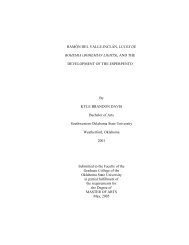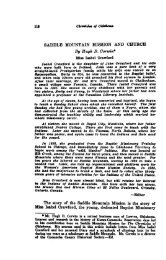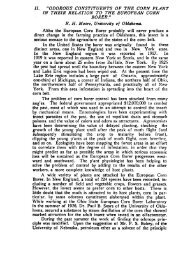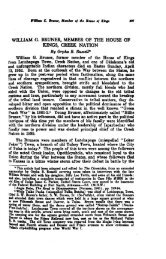tapir behavior- an examination of activity patterns, mother young ...
tapir behavior- an examination of activity patterns, mother young ...
tapir behavior- an examination of activity patterns, mother young ...
You also want an ePaper? Increase the reach of your titles
YUMPU automatically turns print PDFs into web optimized ePapers that Google loves.
individual walked 5.6km to use one (Eisenberg et al., 1990; Williams, 1978)). Thom<br />
(1936) noted “the <strong>an</strong>imal is considered to be holy, <strong>an</strong>d more or less sacred because<br />
periodically about the full <strong>an</strong>d new moon it visits the nearest salt-lick or hot sulphur<br />
springs <strong>of</strong> mineral <strong>an</strong>d saline mud in the vicinity <strong>of</strong> its haunts as if to go into retreat or to<br />
make as it were its orisons.” Artificial salt licks constructed in Tam<strong>an</strong>-Negara National<br />
Park in West Malaysia attract <strong>tapir</strong>s (Eisenberg et al., 1990). Tapirs in Krau Reserve visit<br />
the salt lick 2-3 times a week- more <strong>of</strong>ten th<strong>an</strong> <strong>an</strong>y <strong>of</strong> the other <strong>an</strong>imals in the park;<br />
(Traeholt, 2004). In 1957, Wharton (Williams <strong>an</strong>d Petrides, 1980) suggested that without<br />
salt licks ungulates would have to migrate or perish, but Williams (1978) stated the true<br />
import<strong>an</strong>ce <strong>of</strong> salt licks to <strong>tapir</strong>s remains unknown.<br />
Water usage<br />
The Malay <strong>tapir</strong> is the least aquatic <strong>of</strong> the ext<strong>an</strong>t Tapiridae; however, it is<br />
considered to have <strong>an</strong> “amphibious nature” <strong>an</strong>d readily seeks out marshes <strong>an</strong>d rivers for<br />
swimming (Anon., 1834; Rabinowitz, 1997). Tapirs walk along the bottom as do<br />
hippopotami remaining submerged for long periods (Barongi, 1993; Dudgeon, 2000a;<br />
Dudgeon, 2000b; Morris, 2005). The Malay <strong>tapir</strong>s spend the hottest time <strong>of</strong> the day in the<br />
water <strong>an</strong>d wallow in mud holes, coating their hides with mud to inhibit biting insects<br />
(Eisenberg et al., 1990). The tracks <strong>of</strong> <strong>tapir</strong>s c<strong>an</strong> <strong>of</strong>ten be found at tributaries <strong>an</strong>d <strong>tapir</strong>s<br />
are commonly seen near headwaters, swamps <strong>an</strong>d rivers (Harper, 1945; Kh<strong>an</strong>, 1971).<br />
Frequently they will walk into rivers following them for 100-150m or more (Williams,<br />
1978). Tapirs also use water to escape predation, cool <strong>of</strong>f, <strong>an</strong>d sometimes for mating<br />
(Abdulali, 1952; Eisenberg et al., 1990; McClure, 1963).<br />
25
















